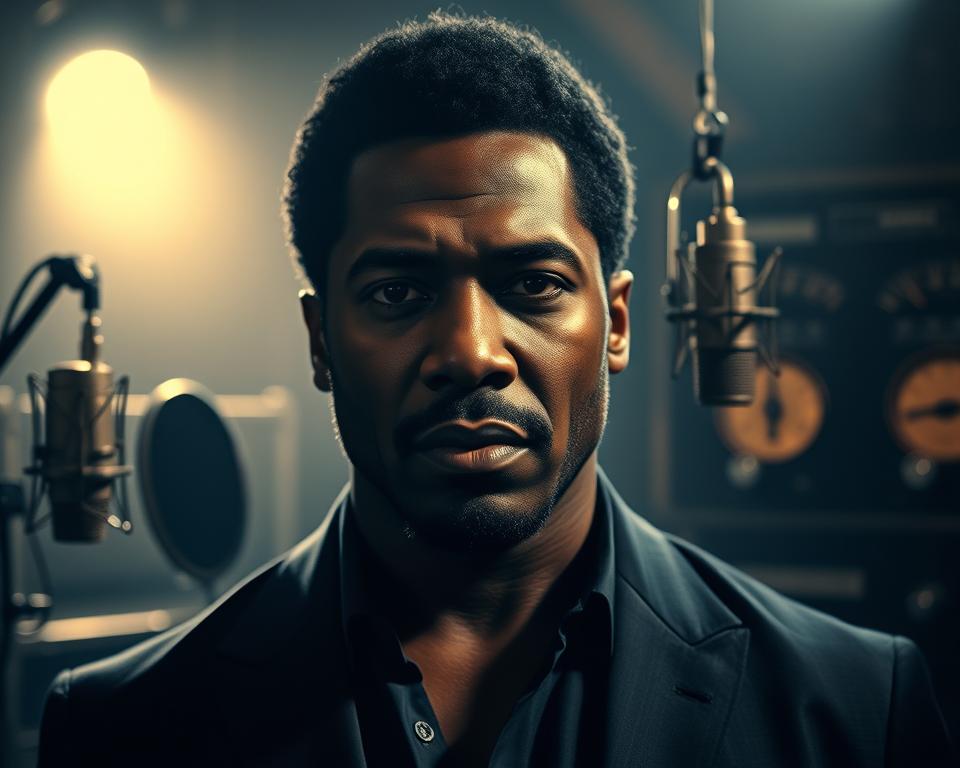Levi Stubbs – The Roaring Baritone That Carried Motown’s Message

With a career spanning decades, the Four Tops, led by the powerful baritone of Levi Stubbs, became one of Motown’s most iconic groups, leaving an indelible mark on the music industry.
Their soulful hits, such as “Reach Out, I’ll Be There” and “Standing in the Shadows of Love,” showcased Stubbs’ emotive vocals, cementing their place in music history.
As a Motown legend, Levi Stubbs played a crucial role in shaping the label’s sound, and his legacy continues to inspire new generations of music lovers.
The Early Years of Levi Stubbs
Levi Stubbs’ journey to becoming a Motown legend began in the vibrant city of Detroit. Growing up in this bustling metropolis, Stubbs was exposed to a diverse range of musical influences that would later shape his distinctive baritone voice.
Birth and Childhood in Detroit
Born on June 6, 1936, in Detroit, Michigan, Levi Stubbs was raised in a family that valued music. Detroit, with its rich cultural heritage and thriving music scene, provided the perfect backdrop for Stubbs’ early musical explorations. The city’s energetic atmosphere and the variety of musical genres on offer had a profound impact on Stubbs’ development as an artist.
Musical Influences and Inspirations
Stubbs’ musical influences were diverse, ranging from gospel music, which he was exposed to in church, to the emerging sounds of R&B and jazz that filled the Detroit airwaves. These influences not only shaped Stubbs’ vocal style but also inspired him to pursue a career in music. As a young man, Stubbs was drawn to the charismatic frontmen of the time, further fueling his ambition to become a leading vocalist.
The combination of Detroit’s vibrant music scene and Stubbs’ innate talent laid the foundation for his future success with The Four Tops, a group that would become synonymous with Motown’s golden era.
Formation of The Four Tops
It was in Detroit that Levi Stubbs met his future bandmates, marking the beginning of The Four Tops. This moment was crucial in shaping Levi Stubbs’ music career. The group’s formation was the result of the coming together of talented individuals who shared a passion for music.
Meeting His Bandmates
Levi Stubbs met his bandmates, including Abdul Fakir, Lawrence Payton, and Renaldo Benson, while they were students. They began performing together, blending their voices in harmony. The chemistry between them was undeniable, and they quickly gained popularity in local circles.
Early Struggles and Breakthroughs
Despite their talent, The Four Tops faced significant challenges in their early days. They struggled to gain recognition and secure record deals. However, their perseverance paid off when they were eventually signed, paving the way for their breakthrough success.
The group’s early struggles taught them valuable lessons that contributed to their later success. With determination and talent, they were able to overcome obstacles and achieve their goals in the competitive music industry.
Signing with Motown Records
Motown Records, founded by Berry Gordy, became the launching pad for The Four Tops’ success with Levi Stubbs as the lead vocalist. This pivotal moment in their career was a result of Gordy’s vision and the label’s dynamic environment. The connection between Berry Gordy and The Four Tops was instrumental in shaping their sound and style.
The Berry Gordy Connection
Berry Gordy’s ability to spot talent and nurture it was a hallmark of Motown Records’ success. When The Four Tops signed with Motown, Gordy’s guidance helped them refine their sound, blending their soulful harmonies with the label’s signature style. Levi Stubbs, with his distinctive baritone, became a standout voice in the Motown roster.
Becoming Part of the Motown Family
As part of the Motown family, The Four Tops, led by Levi Stubbs, became integral to the label’s success. They worked alongside other legendary artists, contributing to the rich musical heritage of Motown. The synergy between the artists and the label’s production team, including the renowned songwriting trio Holland-Dozier-Holland, propelled The Four Tops to new heights.
The Four Tops’ integration into the Motown family not only elevated their career but also played a significant role in defining the sound of Motown Records. Levi Stubbs’ powerful vocals were at the forefront of this success, making him an iconic figure in the Motown legacy.
Levi Stubbs: The Voice That Defined an Era
The voice of Levi Stubbs, with its rich, deep tones, defined the sound of Motown’s legendary group, The Four Tops. As the lead vocalist, Stubbs brought a unique baritone style that was both distinctive and captivating.
Vocal Characteristics and Baritone Style
Levi Stubbs’ vocal characteristics were marked by a powerful, soulful delivery that could convey a wide range of emotions. His baritone voice was a perfect fit for Motown’s signature sound, blending seamlessly with the group’s harmonies. The impact of his voice was evident in the group’s hit songs, where his deep, resonant tone added depth and complexity.
Emotional Delivery and Performance Technique
Stubbs’ emotional delivery was a key factor in The Four Tops’ success. He had a remarkable ability to convey emotion through his singing, making each performance memorable and impactful. This skill, combined with his distinctive baritone style, helped to establish The Four Tops as one of Motown’s most beloved groups.
Chart-Topping Success with The Four Tops
The Four Tops, with Levi Stubbs on lead vocals, achieved unparalleled success in the Motown era. Their music catalog is filled with timeless classics that continue to resonate with audiences today.
Signature Hits and Classics
The Four Tops’ discography boasts an impressive array of hits, including “Reach Out, I’ll Be There” and “Standing in the Shadows of Love.” These songs, characterized by Levi Stubbs’ distinctive baritone, remain staples of Motown’s legacy.
Working with Holland-Dozier-Holland
The collaboration with the renowned songwriting team Holland-Dozier-Holland was a pivotal factor in The Four Tops’ success. Their partnership yielded numerous chart-topping hits, cementing The Four Tops’ status as one of Motown’s premier acts.
Beyond the Microphone
 vintage sound equipment, microphones, and sound-absorbing panels, creating a cozy, professional atmosphere. Stubbs' powerful yet emotive voice resonates through the space, capturing the essence of Motown's soulful expression.">
vintage sound equipment, microphones, and sound-absorbing panels, creating a cozy, professional atmosphere. Stubbs' powerful yet emotive voice resonates through the space, capturing the essence of Motown's soulful expression.">
Levi Stubbs’s impact on the music world was complemented by his ventures into voice acting and appearances on television and film. This diversification not only showcased his versatility as a performer but also contributed significantly to his enduring legacy.
Voice Acting in “Little Shop of Horrors”
One of Stubbs’s most notable roles outside of music was his voice acting in the musical horror-comedy film “Little Shop of Horrors.” Released in 1986, the film featured Stubbs as the voice of Audrey II, the carnivorous plant. His deep, resonant baritone brought the character to life, adding to the film’s cult status.
“Feed me, feed me, feed me!”
became a memorable catchphrase, thanks in large part to Stubbs’s vocal talents.
Television and Film Appearances
In addition to his iconic voice role in “Little Shop of Horrors,” Stubbs made various appearances on television and in films. These appearances further cemented his status as a multifaceted entertainer. Fans of The Four Tops could see Stubbs’s charisma and stage presence shine through in these roles, making him a beloved figure beyond the Motown scene. For more on The Four Tops’ illustrious career, visit The Four Tops’ Legacy.
Personal Life and Later Years
Levi Stubbs’ life beyond the stage was marked by significant personal relationships and challenges. His personal life was a testament to his strength and resilience in the face of adversity.
Marriage and Family Relationships
Stubbs was known to be a devoted family man. He married his wife, Cleo, and they had four daughters together: Tonyann, Nikki, Stubby, and Leron. His family life was filled with love and support, which played a crucial role in his career.
Health Challenges and Final Days
In his later years, Stubbs faced significant health challenges. He suffered from a stroke in 1991, which left him unable to perform with The Four Tops. Despite his health issues, Stubbs remained a beloved figure in the music industry. According to the New York Times, Stubbs passed away on October 17, 2008, leaving behind a legacy of timeless music.
Stubbs’ health challenges did not define his later years; instead, his legacy continued to inspire new generations. His story is a powerful reminder of the impact one person can have on the music world.
The Enduring Legacy of a Motown Pioneer
Levi Stubbs’ legacy continues to resonate through the music of The Four Tops and his influence on subsequent artists. As a Motown pioneer, Stubbs played a pivotal role in shaping the sound of the legendary record label. His distinctive baritone voice and emotive delivery helped define the era, leaving an enduring influence on the music industry.
The Four Tops’ chart-topping hits, such as “Reach Out, I’ll Be There” and “Standing in the Shadows of Love,” remain iconic representations of Motown’s golden era. Stubbs’ vocal style has inspired generations of singers, and his work with The Four Tops continues to be celebrated by fans worldwide.
As a testament to his lasting impact, Levi Stubbs’ music remains relevant, with his songs continuing to be featured in various films, television shows, and commercials. The legacy of this Motown pioneer serves as a reminder of the power of music to transcend time and touch the hearts of audiences across generations.


